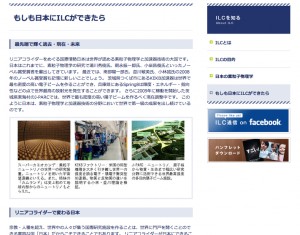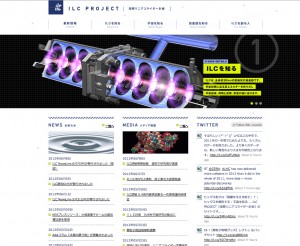On Monday 11 June, Japan’s Advanced Accelerator Association promoting science and technology (AAA) launched a new website where site visitors can get all the information related to the ILC in Japanese.
KEK, Japan’s high-energy physics laboratory, is the Japanese centre of ILC R&D, however KEK’s website is not the most convenient place to learn about the ILC. Because of KEK’s organisational nature, finding ILC-related information on KEK’s web site is not easy. KEK is one of the Inter-University Research Institute Corporations, core research bases operated by the research community which provides researchers from Japan and overseas a place to carry out their work.
KEK consists of four institutes and laboratories: the Accelerator Laboratory, the Applied Research Laboratory, the Institute of Materials Structure Science, and the Institute of Particle and Nuclear Studies (IPNS). KEK’s ILC activities are pursued by two organisations: the Accelerator Laboratory takes care of accelerator developments, and IPNS deals with physics studies and detector R&D. Those activities run web pages under each organisation’s page, which is organisationally correct, but as a result, ILC-related information appears in different places on the web site.

Sections on the website tell visitors more about physics, the ILC technologies and about the ILC's role in Japan.
“Here comes our new website,” announced Masanori Matsuoka, secretary general of AAA on Monday. AAA facilitates industry-government-academia collaboration, seeking various industrial applications of advanced accelerators and technologies derived from R&D on advanced accelerators.
Since last December, when Yoshihiko Noda, prime minister of Japan, addressed the symposium hosted by AAA, demand for ILC-related information has been greatly increasing. “Of course, KEK can provide scientific and technical information about the ILC. But as an industry-government-academia collaboration, we can provide information going further than that,” said Matsuoka.
The new website invites visitors to learn more about the ILC. Trying to make difficult and complicated physics explanations more accessible to the visitors, the website is decorated with friendly features such as animations and cartoons.
Kaori Kurokawa created the particle characters for the pages to explain “what is the Higgs?“. “I tried to describe the characteristic of each particle when I created the cartoon characters. It was pretty tough, but I enjoyed the thinking process,” said Kurokawa.
The new site also has a page that introduces people involved in ILC activities, or animations to explain how to accelerate an electron (see this week’s Video of the Week!). “We are planning to add more information, such as industrial applications of accelerators in the near future. Please visit our new web site, and give us your feedback,” Matsuoka said.



The new website for the ILC in Japan does not seem to have an English version. We need an English version.
Dear Richard,
Thanks for your interest in the new Japanese ILC website. The AAA-hosted Japanese website and the main ILC website share a substantial overlap in ILC content, and so you might consider the new website as the Japanese counterpart to the English-language linearcollider.org. ILC research in Japan that is also of interest to a global audience will continue to appear in ILC NewsLine.
Another thing to consider is that Japan is exceptionally interested in learning about the ILC, but until now, the only web choice for Japanese non-English speakers was the KEK-hosted, rather inconvenient-to-access ILC webpage. The new Japanese site fills an urgent need for the Japanese community where was very little for them before. The enthusiasm of the Japanese community merited a dedicated Japanese-language site.